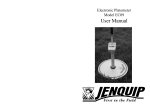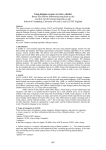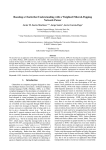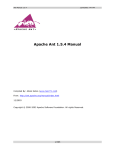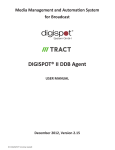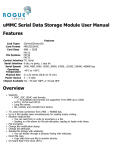Download - TRAP@NCI - National College of Ireland
Transcript
BSc (Hons) in Business Information Systems (Year 4)
Investment Explorer
A first touch automated response to Novice
Investor Queries
Technical Report
Prepared by Sheila O‟Donnell
May 12, 2012
Sheila O‟Donnell, 11109815
1
1 Abstract
Meetings between financial advisors and their clients are often
taken up with explanations about straight-forward financial terms.
While these terms may be straight-forward to the financial advisor,
they are not for the client. This application gives the client a
medium through which to gather information but frees the financial
advisor as the answer need only be given once to populate the
knowledge base. After that, the application responds to the client.
The application uses an AIML engine to try to mimic a human
response to the questions asked. Communication is via email.
The interaction is simple but a useful starting point for the user.
Sheila O‟Donnell, 11109815
2
1 Abstract................................................................................ 2
Introduction................................................................................ 4
1.1 Background ..................................................................... 4
1.2 Aims ............................................................................... 4
1.3 Technologies.................................................................... 4
1.3.1 Java in Eclipse IDE ...................................................... 4
1.3.2 JUnit ......................................................................... 5
1.3.3 Spring ....................................................................... 8
1.3.4 Ant ........................................................................... 8
1.3.5 ProgramD .................................................................. 8
1.3.6 AIML ......................................................................... 9
1.3.7 MySQL ...................................................................... 9
1.3.8 IMAP/SMTP ................................................................ 9
1.3.9 Tomcat ..................................................................... 10
2 System ................................................................................ 11
2.1 System Architecture ........................................................ 11
2.2 Process Flow Diagram ...................................................... 12
2.3 Code base Structure ........................................................ 13
2.4 Requirements ................................................................. 13
2.4.1 Functional Requirements ............................................ 13
2.4.2 Data Requirements .................................................... 15
2.4.3 User Requirements .................................................... 15
2.4.4 Environmental Requirements....................................... 16
2.4.5 Usability Requirements ............................................... 16
2.5 Evaluation ...................................................................... 17
2.5.1 Unit Testing .............................................................. 17
2.5.2 System Testing ......................................................... 17
3 Conclusions & Recommendations ............................................ 20
3.1 Application Improvements ................................................ 20
3.2 Implementation Improvements ......................................... 20
4 Bibliography ......................................................................... 21
5 Appendix ............................................................................. 22
5.1 Database create script ..................................................... 22
5.2 Ant build file ................................................................... 22
5.3 Ieexplorer-start.bat ......................................................... 29
5.4 AIML generator bat.......................................................... 30
5.5 AIML files ....................................................................... 30
5.6 Project Proposal .............................................................. 30
5.7 Project Plan .................................................................... 35
5.8 Requirements Specification ............................................... 36
Sheila O‟Donnell, 11109815
3
Introduction
1.1 Background
It can be difficult to find consistent information about financial
products and services in Ireland. In particular, many terms that
are used on foreign publications are not used here and therefore
difficult to understand.
The application already has a foundation of useful terms built in but
an experienced business user can improve the service by adding
additional terms and publishing to the application.
Users send emails asking questions which are answered by the
application using the knowledge base.
1.2 Aims
Seamless communication between the user and the
application
Give human-like responses
Easy to support the application and update the knowledge
base
1.3 Technologies
1.3.1 Java in Eclipse IDE
Java in Eclipse was chosen as the main programming language
because it encourages writing modular code. This in turn facilitated
writing effective test scripts. It is a mature programming language
with significant support forums available.
The screenshot below shows the package structure where the
modular nature of the project can be clearly seen.
Breaking the code in to modules allows it to be easily understood
and maintained.
Sheila O‟Donnell, 11109815
4
1.3.2 JUnit
1.3.2.1 Overview
As part of the evaluation process, I needed to write effective test
scripts.
JUnit provides a systematic approach to testing and
integrates well with Eclipse. It provides a method by which the
developer can verify that the latest changes haven‟t broken the
build.
The figure below shows the impact of a change made to the code
base that has caused a test to fail. By running the test, the
developer can determine what impact his change has. It is an early
warning that the build may be broken.
This is particularly useful when working in a group on a large code
base as it deters a developer from checking in a change that fails
the JUnit test.
Sheila O‟Donnell, 11109815
5
1.3.2.2 JUnit Example
The following is an example of the type of tests that were created in
order to test and regression test the software.
While parsing the users email, we need to identify and present
questions to the knowledge base. The following test verifies the
getQuestion() method of the ParseService class.
We present „question‟ and „noQuestion‟ to the method. If the class
returns the expected response, the test will pass. If not, it will fail.
Sheila O‟Donnell, 11109815
6
/**
* Identify questions
*/
@Test
public void testGetQuestion() {
String question = "Am I a question?";
String noQuestion = "I am not a question.";
String q = parseService.getQuestion(question);
String nq = parseService.getQuestion(noQuestion);
if (q != null && q.length() > 0 && nq == null) {
assertTrue("Found the question, ignored the non-question.", true);
}
else {
fail("That didn't work.");
}
}
1.3.2.3 Test Execution
Eclipse allows all tests to be executed and shows the result of the
test output. This feedback is shown below.
As can be seen, there are 21 JUnit tests that have been executed in
under 20 seconds. This is a useful and efficient way to regularly
verify the code base.
Sheila O‟Donnell, 11109815
7
1.3.2.4 Test Configuration
The tests are configured in ServiceTest-context.xml file which can
be found in the package under test/resources.
An example bean configuration is
<bean id="parseService"
class="org.aitools.programd.sod.service.ParseService"/>
1.3.3 Spring
Where possible I have used the Spring Framework to simplify the
development process.
Spring is the most popular application
development framework for enterprise Java*.
Spring facilitates the development of code that is
1. Easily tested
2. Reusable
3. Clearly structured
Specifically, Spring simplified database access for the application
through the use of the JdbcTemplate object.
Spring objects were also used in the JUnit test scripts.
1.3.4 Ant
Apache Ant is a command line tool which builds a code base by
following the instructions defined in the build file (build.xml). It is
used in a similar fashion to „make‟ in Unix.
It provides a robust and consistent build process. In order to start
the build, the user should navigate to the project folder
(c:\ProgramD) and call „ant‟.
C:\ProgramD>c:\apache-ant-1.8.2\bin\ant
The build.xml for this project is included in the Appendix.
1.3.5 ProgramD
ProgramD is the AIML platform that I have chosen to build into this
application. According to its website†, it is the most widely used
open-source AIML bot platform.
*
Source: www.springsource.org
Sheila O‟Donnell, 11109815
8
1.3.6 AIML
AIML is an XML-compliant language which allows the user to
configure automated responses from a bot. The important units of
an AIML document are
<aiml> - tag that begins and ends the XML document.
<category> - tag that marks a unit of knowledge in the knowledge
base.
<pattern> - tag that contains a simple pattern that the bot can
match against.
<template> - tag that contains a detailed response to the pattern
given above.
1.3.7 MySQL
1.3.7.1 Overview
MySQL is an open source database. It is reliable and easy to use
and has a mature support structure which aides in the resolution of
development issues.
1.3.7.2 Configuration Settings
The
database
settings
c:\programd\conf\db.properties.
are
configured
in
driver=com.mysql.jdbc.Driver
url=jdbc:mysql:///iehobbes
username=maureen
password=password
1.3.8 IMAP/SMTP
1.3.8.1 Overview
IMAP stands for internet message access protocol and is used to
read incoming emails.
SMTP stands for simple mail transfer protocol and is used to send
outgoing emails.
†
www.aitools.org/Program_D
Sheila O‟Donnell, 11109815
9
Gmail (www.gmail.com) is the host that is used to relay emails for
this application.
1.3.8.2 Configuration Settings
Email settings are configured in C:\ProgramD\conf\email.properties.
[email protected]
username=iehobbes
password=colette.8
host=smtp.gmail.com
port=587
1.3.9 Tomcat
Tomcat is included as part of the ProgramD application.
have used it to test the generated AIML file.
Here I
The name (“YourBot”) of the bot is specified in properties.xml under
c:\programd\conf.
Sheila O‟Donnell, 11109815
10
2 System
2.1 System Architecture
High Level System Architecture Diagram is shown below.
All
components except the Gmail server are installed on one server.
Sheila O‟Donnell, 11109815
11
2.2 Process Flow Diagram
Check if there‟s a new email
If so, parse the message and find the questions
Present the questions to the knowledge base engine
Add the answers given to the message. Add any unknowns to the message
If the user is unknown, create in the database
Store the answers against the user
Send the message to the user
Sheila O‟Donnell, 11109815
12
2.3 Code base Structure
The application code base is built on the existing ProgramD code
base and follows the package structure of same.
All code under the structure org.aitools.programd.sod was
written by me.
All code in the Eclipse project was written by me.
All other code belongs to Noel Bush as the original owner of
ProgramD.
All code is included on the CD. Only the code that I‟ve written has
been uploaded to moodle.
2.4 Requirements
2.4.1 Functional Requirements
The key functional requirements can be identified as
2.4.1.1 Email Exchange
Gmail provides a POP and IMAP interface which allows users to
download messages from the Gmail servers without using the web
GUI.
Equally, Gmail also provides support for sending email messages
through an SMTP gateway.
As this is a fundamental requirement of the application, it is
considered a high priority deliverable.
Risks & Technical Issues
There were no technical issues setting up email exchange.
As the application requires internet connectivity in order to function,
there is a risk that it will not work if this is not available.
2.4.1.2 Database Access
In order to maintain a history of interactions with users, a database
was required. The schema is shown below;
Sheila O‟Donnell, 11109815
13
IE_USERS table stores the users who have interacted with the
application.
IE_CONVERSATION stores the topics that a user has asked about.
IE_TOPIC stores the knowledge of the application.
IE_UNKNOWN stores the questions that there is no answer in the
knowledge base for.
IE_RAW_MESSAGE stores the incoming and outgoing messages.
Risks & Technical Issues
There were no technical issues setting up the MySQL instance.
2.4.1.3 AIML Parser
One of the key requirements was the identification of an AIML
parser.
Program D is the mostly widely used open source AIML bot
platform‡. It has an open architecture which facilitated integration
into my code base.
It is implemented in Java and I found it to be a robust AIML engine.
Risks & Technical Issues
‡
From www.aitools.org
Sheila O‟Donnell, 11109815
14
There is limited community activity. Any issues or problems need
to be resolved in isolation.
2.4.2 Data Requirements
Data requirements for this application were focused on gathering
and collating definitions and explanations for common and
uncommon financial terms.
This information was obtained from many sources which are listed
in the bibliography.
2.4.3 User Requirements
2.4.3.1 Generating AIML
In order to facilitate setting up the application, a program was
written which transforms a Microsoft Excel spreadsheet into an
AIML file.
The reason for this is that in most business situations, it is
preferable that the business owner can manage the application
themselves without constantly having to refer back to their IT
resources.
The AIML is generated by running the following batch file;
C:\ProgramD\bin>aiml_gen.bat
The batch file starts the main class IEAIMLGenerator.class.
In a production environment, this would be setup as a scheduled
task. The onus would rest with the business user to update the
document before the scheduled task ran.
2.4.3.2 Running application
The main application program is also run from a batch file.
program is started by running the following;
The
C:\ProgramD\bin>ieexplorer-start.bat
This calls a batch file that starts the main class IEExplorer.class.
Sheila O‟Donnell, 11109815
15
An obvious improvement to this process would be to configure the
application as a windows service thereby negating the need to
interactively log on in order to start the application.
2.4.4 Environmental Requirements
The application requires the following to run;
1. Internet access in order to send and receive emails
The application requires the following to build;
1. Apache Ant
2. Java 1.7
2.4.5 Usability Requirements
The user is expected to use email in order to interact with the
application. It is assumed that the user is familiar with sending and
receiving emails.
A sample email sent and received is shown below;
Sent:
Received:
Sheila O‟Donnell, 11109815
16
2.5 Evaluation
2.5.1 Unit Testing
Unit testing ensures that the functionality of each core component
is correct. For this development, I used JUnit to unit test as well as
ad hoc testing.
The JUnit tests are described earlier in this
document (section 2.3.2).
Unit testing of the AIML code generated was also carried out on an
ad hoc basis using the tomcat interface. This was quicker than
waiting for an email response and easier to track that the correct
answers were given.
2.5.2 System Testing
The purpose of the system testing is to ensure that all components
work together correctly. The following system tests were carried
out;
Test
Name
Empty Email sent to Investment Explorer
Before
Access to the internet
Access to an email client
Steps
Create an email
Address to [email protected]
Leave subject blank
Leave body blank
Send
Expected
Investment Explorer will respond but will ask
the user to re-phrase their question
Result
PASS
Test
Name
Email with one question
Before
Access to the internet
Access to an email client
Sheila O‟Donnell, 11109815
17
Steps
Create an email
Address to [email protected]
Add a subject
Add a question to the body
Send
Expected
1 answer returned
Result
PASS
Test
Name
Email with many questions
Before
Access to the internet
Access to an email client
Steps
Create an email
Address to [email protected]
Add a subject
Add 3 questions to the body
Send
Expected
3 answers returned
Result
PASS
Test
Name
Email with 1 unknown question
Before
Access to the internet
Access to an email client
Steps
Create an email
Address to [email protected]
Add a subject
Add 1 question that there is no answer in the
KB
Send
Expected
Response will tell user that IE doesn't know
Result
PASS
Sheila O‟Donnell, 11109815
18
Test
Name
Email with many questions, 1 unknown
Before
Access to the internet
Access to an email client
Steps
Create an email
Address to [email protected]
Add a subject
Add 3 questions that are known and 1 unknown
Send
Expected
3 answers and 1 response saying that IE
doesn't know
Result
PASS
Sheila O‟Donnell, 11109815
19
3 Conclusions & Recommendations
3.1 Application Improvements
The parsing algorithm that is used in the application is very simple.
A significant improvement to the application might be achieved by
utilising a natural language programming package such as Apache
OpenNLP (http://opennlp.apache.org/) to tokenise and parse the
emails.
3.2 Implementation Improvements
It would be useful if the main class IEExplorer.class were installed
as windows service. In that way, it wouldn‟t be necessary to logon
interactively to start the process; it could be running whenever the
server is available.
Unknown questions are currently stored in the database. It would
be an improvement if the application regularly scanned this table
and notified the admin user that these questions were missing
rather than it being an action that must be driven by the user.
The AIML generator should accept CSV files as well as Microsoft
Excel as this would negate the need to have Microsoft Excel
installed.
However as Excel is ubiquitous in a business
environment, this improvement might be redundant.
Sheila O‟Donnell, 11109815
20
4 Bibliography
Apache POI http://poi.apache.org/
Bush, N. Program D website. http://aitools.org/Main_Page
Davy Stockbrokers website. http://www.davy.ie
Irish Stock Exchange website. http://www.ise.ie
Flanagan, D. 2005. Java in a Nutshell, 5th Edition.
Git Community. http://git-scm.com/
Janetzko, D. 2008. Assistance and Assessment in Tutorial Dialogues
that Operate via E-mail.
SpringSource Community. http://www.springsource.org/
U.S. Securities and Exchange Commission website.
http://www.sec.gov/index.htm
Walls, C. 2011. Spring in Action.
Sheila O‟Donnell, 11109815
21
5 Appendix
5.1 Database create script
create table if not exists ie_users(
id INT not null auto_increment,
name varchar(100) default '',
email varchar(100) default '',
last_contact DATE,
PRIMARY KEY (id)
);
create table if not exists ie_raw_message(
id INT not null auto_increment,
sender varchar(100) default '',
subject varchar(500) default '',
date_sent date,
body varchar(5000) default '',
PRIMARY KEY (id)
);
create table if not exists ie_topic(
id INT not null auto_increment,
pattern varchar(250) default '',
template varchar(5000) default '',
PRIMARY KEY (id));
create table if not exists ie_conversation(
id INT not null auto_increment,
user_id INT not null,
topic_id INT not null,
PRIMARY KEY (id));
alter table ie_conversation add CONSTRAINT fk_ie_topic FOREIGN KEY
(topic_id) references ie_topic (id);
alter table ie_conversation add CONSTRAINT fk_ie_user FOREIGN KEY
(user_id) references ie_users (id);
create table if not exists ie_unknown(
id INT not null auto_increment,
question varchar(5000) default '',
user_id INT not null,
PRIMARY KEY (id));
alter table ie_unknown add CONSTRAINT fk_ie_user_unknown FOREIGN KEY
(user_id) references ie_users (id);
5.2 Ant build file
This is the ant build file that came with the ProgramD code base. I
have edited to accommodate my new code.
<project default="jars" basedir=".">
Sheila O‟Donnell, 11109815
22
<!--Initialization Target-->
<target name="init">
<tstamp />
<property name="Name" value="Program D" />
<property name="version" value="4.6" />
<property name="year" value="2006" />
<property
<property
<property
<property
<property
<property
name="javac.compiler" value="modern" />
name="javac.debug" value="on" />
name="javac.optimize" value="on" />
name="javac.deprecation" value="on" />
name="javac.jvm-target" value="1.5" />
name="javac.source" value="1.5" />
<property name="src.dir" value="${basedir}/JavaSource" />
<property name="webapp.dir" value="${basedir}/WebContent" />
<property name="webapp.lib.dir" value="${webapp.dir}/WEBINF/lib" />
<property name="compile.lib.dir" value="${basedir}/lib" />
<property name="distrib.dir" value="${basedir}/distrib" />
<property name="spring.dir" value="C:/Program
Files/springsource/sts-2.8.1.RELEASE/plugins" />
<property name="build.dir" value="${basedir}/build.tmp" />
<path id="build.classpath">
<pathelement location="${compile.lib.dir}/gnu.getopt1.0.10.jar" />
<pathelement location="${compile.lib.dir}/jsp-api.jar" />
<pathelement location="${webapp.lib.dir}/js.jar" />
<pathelement location="${compile.lib.dir}/servlet-api.jar"
/>
<pathelement location="${webapp.lib.dir}/log4j-1.2.13.jar"
/>
<pathelement location="${webapp.lib.dir}/mail.jar" />
<pathelement
location="${spring.dir}/org.springframework.jdbc_3.1.0.RC1.jar" />
</path>
<property name="javadoc.dir" value="${basedir}/docs/api" />
<property name="main.jar" value="${distrib.dir}/programdmain.jar" />
<property name="rhino.jar" value="${distrib.dir}/programdrhino.jar" />
<property name="war" value="${distrib.dir}/programd.war" />
<property name="distrib.src.dir"
value="${distrib.dir}/distrib.src.tmp" />
<property name="distrib.bin.dir"
value="${distrib.dir}/distrib.bin.tmp" />
<property name="distrib.war.dir"
value="${distrib.dir}/distrib.war.tmp" />
<property name="distrib.src.zip" value="${distrib.dir}/programd${version}-src.zip" />
<property name="distrib.bin.zip" value="${distrib.dir}/programd${version}-bin.zip" />
Sheila O‟Donnell, 11109815
23
<property name="distrib.war.zip" value="${distrib.dir}/programd${version}-war.zip" />
<property name="distrib.src.tar.bz2"
value="${distrib.dir}/programd-${version}-src.tar.bz2" />
<property name="distrib.bin.tar.bz2"
value="${distrib.dir}/programd-${version}-bin.tar.bz2" />
<property name="distrib.war.tar.bz2"
value="${distrib.dir}/programd-${version}-war.tar.bz2" />
<filter
<filter
<filter
<filter
<filter
token="year" value="${year}" />
token="version" value="${version}" />
token="date" value="${TODAY}" />
token="log" value="true" />
token="verbose" value="true" />
</target>
<!--Generate CoreSettings from core.xml.-->
<target name="core-settings" depends="init">
<xslt in="conf/core.xml"
out="JavaSource/org/aitools/programd/CoreSettings.java"
style="resources/xslt/generate-settings-class.xslt">
<factory name="net.sf.saxon.TransformerFactoryImpl" />
</xslt>
</target>
<!--Prepare the build directory.-->
<target name="prepare" depends="init">
<mkdir dir="${build.dir}" />
</target>
<!--Prepare the source code.-->
<target name="prepare-src" depends="init, prepare">
<mkdir dir="${build.dir}" />
<!--Copy resources.-->
<copy todir="${build.dir}">
<fileset dir="${webapp.dir}" includes="resources/schema/**"
/>
</copy>
</target>
<!--Compile the source directory.-->
<target name="compile" depends="init, prepare-src">
<javac srcdir="${src.dir}" destdir="${build.dir}"
classpathref="build.classpath" debug="${javac.debug}"
deprecation="${javac.deprecation}" optimize="${javac.optimize}"
target="${javac.jvm-target}" source="${javac.source}">
<compilerarg value="-Xlint" />
<compilerarg value="-Xlint:-path" />
<compilerarg value="-Xlint:-serial" />
</javac>
</target>
<!--Create the jars.-->
<target name="jars" depends="init, compile">
<mkdir dir="${distrib.dir}" />
<jar jarfile="${main.jar}">
Sheila O‟Donnell, 11109815
24
<fileset dir="${build.dir}/" includes="org/**"
excludes="org/aitools/programd/interpreter/RhinoInterpreter.class" />
<fileset dir="${src.dir}/"
includes="org/aitools/programd/gui/icons/**" />
<fileset dir="${build.dir}/" includes="resources/schema/**"
/>
</jar>
<jar jarfile="${rhino.jar}">
<fileset dir="${build.dir}/"
includes="org/aitools/programd/interpreter/RhinoInterpreter.class" />
</jar>
</target>
<!--Create a WAR file.-->
<target name="war" depends="init, compile">
<delete file="${war}" />
<war destfile="${war}" webxml="${webapp.dir}/WEB-INF/web.xml"
manifest="${webapp.dir}/META-INF/MANIFEST.MF">
<fileset dir="${webapp.dir}">
<include name="pages/**" />
</fileset>
<fileset dir="${basedir}">
<include name="resources/**" />
<exclude name="resources/database/**" />
<exclude name="resources/icons/**" />
<exclude name="resources/testing/**" />
<exclude name="resources/xslt/**" />
</fileset>
<lib dir="${webapp.lib.dir}" />
<classes dir="${build.dir}" />
<classes dir="${basedir}/conf">
<include name="log4j.xml" />
</classes>
<webinf dir="${webapp.dir}/WEB-INF">
<include name="aiml.tld" />
<include name="c.tld" />
<include name="c-rt.tld" />
<include name="dwr.xml" />
</webinf>
</war>
</target>
<!--Create the API documentation.-->
<target name="javadoc" depends="init, prepare-src">
<mkdir dir="${javadoc.dir}" />
<javadoc packagenames="*" sourcepath="${src.dir}"
destdir="${javadoc.dir}" classpathref="build.classpath" author="true"
version="true" use="true" splitindex="true" noindex="false"
windowtitle="${Name} API" doctitle="${Name} API">
<link href="http://java.sun.com/j2se/1.5.0/docs/api/" />
<link
href="http://www.urbanophile.com/arenn/hacking/getopt/" />
<link href="http://java.sun.com/j2ee/1.4/docs/api/" />
</javadoc>
</target>
<!--Create the schema documentation.-->
Sheila O‟Donnell, 11109815
25
<target name="schema-doc" depends="init">
<property name="xs3p" value="/usr/local/xs3p/xs3p.xsl" />
<property name="schema" value="../resources/schema" />
<property name="schema-doc" value="../docs/schema" />
<delete dir="${schema-doc}" />
<xslt in="${schema}/AIML.xsd" out="${schema-doc}/AIML.html"
style="${xs3p}">
<param name="title" expression="A Schema for AIML 1.0.1" />
<param name="sortByComponent" expression="false" />
</xslt>
<xslt in="${schema}/bot-configuration.xsd" out="${schemadoc}/bot-configuration.html" style="${xs3p}">
<param name="title" expression="Program D Bot Configuration
Schema" />
<param name="sortByComponent" expression="false" />
</xslt>
<xslt in="${schema}/ChatLog.xsd" out="${schemadoc}/ChatLog.html" style="${xs3p}">
<param name="title" expression="Program D Chat Log Schema"
/>
<param name="sortByComponent" expression="false" />
</xslt>
<xslt in="${schema}/test-cases.xsd" out="${schema-doc}/testcases.html" style="${xs3p}">
<param name="title" expression="Program D Test Suite Schema"
/>
<param name="sortByComponent" expression="false" />
</xslt>
</target>
<!--Make the distribs.-->
<target name="distribs" depends="init, source-distribs, binarydistribs, war-distribs" />
<!--The source distribs.-->
<target name="source-distribs" depends="init">
<delete dir="${distrib.src.dir}" />
<copy todir="${distrib.src.dir}">
<fileset dir="${basedir}">
<exclude name=".*" />
<exclude name=".*/**" />
<exclude name="aiml/**" />
<exclude name="build.tmp/**" />
<exclude name="classes/**" />
<exclude name="distrib/**" />
<exclude name="docs/**" />
<exclude name="ffm/**" />
<exclude name="lib/*-listener/*.jar" />
<exclude name="logs/**" />
</fileset>
</copy>
<zip destfile="${distrib.src.zip}">
<zipfileset dir="${distrib.src.dir}" prefix="ProgramD/">
<exclude name="bin/simple-console" />
<exclude name="bin/simple-gui-console" />
</zipfileset>
Sheila O‟Donnell, 11109815
26
<zipfileset dir="${distrib.src.dir}" prefix="ProgramD/"
filemode="744">
<include name="bin/simple-console" />
<include name="bin/simple-gui-console" />
</zipfileset>
</zip>
<tar destfile="${distrib.src.tar.bz2}" compression="bzip2">
<tarfileset dir="${distrib.src.dir}" prefix="ProgramD/">
<exclude name="bin/simple-console" />
<exclude name="bin/simple-gui-console" />
</tarfileset>
<tarfileset dir="${distrib.src.dir}" prefix="ProgramD/"
mode="744">
<include name="bin/simple-console" />
<include name="bin/simple-gui-console" />
</tarfileset>
</tar>
<delete dir="${distrib.src.dir}" />
</target>
<!--The binary distribs.-->
<target name="binary-distribs" depends="init, jars">
<delete dir="${distrib.bin.dir}" />
<copy todir="${distrib.bin.dir}">
<fileset dir="${basedir}">
<include name="**" />
<exclude name=".*" />
<exclude name=".*/**" />
<exclude name="aiml/**" />
<exclude name="build.tmp/**" />
<exclude name="build.xml" />
<exclude name="classes/**" />
<exclude name="distrib/**" />
<exclude name="docs/**" />
<exclude name="ffm/**" />
<exclude name="lib/*-listener/*.jar" />
<exclude name="logs/**" />
<exclude name="JavaSource/**" />
<exclude name="secret.key" />
</fileset>
<fileset dir="${basedir}">
<include name="distrib/programd-main.jar" />
<include name="distrib/programd-rhino.jar" />
</fileset>
</copy>
<zip destfile="${distrib.bin.zip}">
<zipfileset dir="${distrib.bin.dir}" prefix="ProgramD/">
<exclude name="bin/simple-console" />
<exclude name="bin/simple-gui-console" />
</zipfileset>
<zipfileset dir="${distrib.bin.dir}" prefix="ProgramD/"
filemode="744">
<include name="bin/simple-console" />
<include name="bin/simple-gui-console" />
</zipfileset>
</zip>
<tar destfile="${distrib.bin.tar.bz2}" compression="bzip2">
Sheila O‟Donnell, 11109815
27
<tarfileset dir="${distrib.bin.dir}" prefix="ProgramD/">
<exclude name="bin/simple-console" />
<exclude name="bin/simple-gui-console" />
</tarfileset>
<tarfileset dir="${distrib.bin.dir}" prefix="ProgramD/"
mode="744">
<include name="bin/simple-console" />
<include name="bin/simple-gui-console" />
</tarfileset>
</tar>
<delete dir="${distrib.bin.dir}" />
</target>
<!--The war distribs.-->
<target name="war-distribs" depends="init, war">
<delete dir="${distrib.war.dir}" />
<copy todir="${distrib.war.dir}">
<fileset dir="${basedir}">
<include name="conf/**" />
<include name="resources/testing/AIML.aiml" />
<include name="resources/testing/AIML.xml" />
</fileset>
<fileset dir="${distrib.dir}">
<include name="programd.war" />
</fileset>
</copy>
<zip destfile="${distrib.war.zip}">
<zipfileset dir="${distrib.war.dir}" prefix="ProgramD/" />
</zip>
<tar destfile="${distrib.war.tar.bz2}" compression="bzip2">
<tarfileset dir="${distrib.war.dir}" prefix="ProgramD/" />
</tar>
<delete dir="${distrib.war.dir}"/>
</target>
<!--Clean up everything.-->
<target name="clean" depends="init, buildclean, distclean"/>
<!--Clean the build stuff.-->
<target name="buildclean" depends="init">
<delete dir="${build.dir}"/>
<delete file="${main.jar}"/>
<delete file="${rhino.jar}"/>
</target>
<!--Clean up all the distrib stuff.-->
<target name="distclean" depends="init, source-distclean, binarydistclean, war-distclean"/>
<!--Clean up the source distribs.-->
<target name="source-distclean" depends="init">
<delete dir="${distrib.src.dir}"/>
<delete file="${distrib.src.zip}"/>
<delete file="${distrib.src.tar.bz2}"/>
</target>
<!--Clean up the binary distribs.-->
Sheila O‟Donnell, 11109815
28
<target name="binary-distclean" depends="init">
<delete dir="${build.dir}"/>
<delete file="${main.jar}"/>
<delete file="${rhino.jar}"/>
<delete dir="${distrib.bin.dir}"/>
<delete file="${distrib.bin.zip}"/>
<delete file="${distrib.bin.tar.bz2}"/>
</target>
<!--Clean up the war distribs.-->
<target name="war-distclean" depends="init">
<delete file="${war}"/>
<delete dir="${distrib.war.dir}"/>
<delete file="${distrib.war.zip}"/>
<delete file="${distrib.war.tar.bz2}"/>
</target>
<!--Generate the multibot test files.-->
<target name="multibot" depends="init">
<delete file="resources/testing/multibot/bots.xml"/>
<xslt in="resources/xslt/generate-multibot.xslt"
out="resources/testing/multibot/bots.xml"
style="resources/xslt/generate-multibot.xslt">
<factory name="net.sf.saxon.TransformerFactoryImpl"/>
</xslt>
</target>
</project>
5.3 Ieexplorer-start.bat
This is the main program batch file that runs the application ieexplorer-start.bat.
@echo off
@rem Reset the quit variable.
set quit=
@rem Enter the bin directory.
pushd "%~p0"
@rem Check for needed environment space.
call common_functions.bat check_env %1 %2 %3 %4
@rem Get "base" directory (root of Program D installation)
if "%quit%"=="" call common_functions.bat set_base
@rem Configuration
set MAIN_CLASS=org.aitools.programd.sod.IEExplorer
set START_MEM=128m
set MAX_MEM=256m
set CORE_CONF=%BASE%\conf\core.xml
@rem Start Program D using the SimpleConsole main class.
if "%quit%"=="" call common_functions.bat start_programd
%MAX_MEM% "%CORE_CONF%"
%MAIN_CLASS%
%START_MEM%
:end
@rem On exit, go back to the original directory.
popd
Sheila O‟Donnell, 11109815
29
This script depends on the common_functions.bat which is included
in the build CD.
5.4 AIML generator bat
This is the AIML generator bat - aiml_gen.bat. It transforms the
MS Excel file created by a business user into an AIML document
that the application can consume.
@echo off
@rem Reset the quit variable.
set quit=
@rem Enter the bin directory.
pushd "%~p0"
@rem Configuration
set MAIN_CLASS=org.aitools.programd.sod.IEAIMLGenerator
@rem set the classpath
set CLASSPATH="c:\program files\springsource\sts2.8.1.RELEASE\plugins\org.springframework.jdbc_3.1.0.RC1.jar;C:\Program
Files\springsource\sts2.8.1.RELEASE\plugins\org.springframework.core_3.1.0.RC1.jar;C:\Program
Files\springsource\sts2.8.1.RELEASE\plugins\org.springframework.beans_3.1.0.RC1.jar;C:\Program
Files\springsource\sts2.8.1.RELEASE\plugins\org.springframework.transaction_3.1.0.RC1.jar;C:\Program
Files\springsource\sts2.8.1.RELEASE\plugins\org.springframework.asm_3.1.0.RC1.jar;C:\axis-1_4\lib\commonslogging-1.0.4.jar;C:\ProgramD\lib\mysql-connector-java-3.1.12bin.jar;c:\programd\distrib\programd-main.jar;c:\programd\lib\poi-3.820120326.jar;c:\programd\lib\poi-ooxml-3.8-20120326.jar"
@rem run the generator
if "%quit%"=="" java -cp %CLASSPATH% %MAIN_CLASS% "C:\Documents and Settings\Sheila\My
Documents\NCIRL\Dropbox\Project\Glossary.xls" C:\ProgramD\aiml\sod\glossary.aiml
@rem For tomcat testing, copy to
copy C:\ProgramD\aiml\sod\glossary.aiml C:\var\programd\resources\testing
:end
@rem On exit, go back to the original directory.
popd
5.5 AIML files
The AIML files generated are available in c:\programd\aiml\sod and
are included on the CD.
5.6 Project Proposal
Project Proposal
Sheila O‟Donnell, 11109815
30
Investment Explorer
Sheila O‟Donnell, 11109815, [email protected]
Degree Programme Name e.g. BSc (Hons) in Business Information
Systems
23/09/2011
Sheila O‟Donnell, 11109815
31
Objectives
This project will build an expert system that will explore the
difficulties of human/machine interaction. It will endeavour to
overcome the typical problems that arise in these systems and will
explore the following objectives ;
Explore internet application development with specific emphasis on
SMTP/IMAP and the Twitter API
Understand the difficulties that exist in human/machine
communication
Create a system that will interact „intelligently‟ with a human
counterpart. The aim will be to move towards a solution that is
indistinguishable from a human response.
Utilise languages and technologies in a way to expand my
understanding of their power and functionality
Background
Interaction between humans and machines has always presented
problems typically due to the unpredicable way that humans
communicate. Artifical Intelligence is the science and engineering
of making intelligent machines, especially intelligent computer
programs. It is related to the similar task of using computers to
understand human intelligence§
This project will build an AIML system with a developed knowledge
base that will interact with humans via email and twitter. The
content of the knowledge base will likely be an expert on products
available to retail investors** in Ireland. The system will attempt to
answer typical questions about the availibility of assets, the risks
associated with same and the likely return on investment.
The system will attempt to be aware of its own limitations and
forward the question to a human if it is beyond its knowledge base.
Technical Approach
The technical approach will be as follows;
Research & Design
Research
Requirements Analysis – document clearly the deliverables.
Testing/Validation Plan – document an ongoing
testing/validation plan (system test) as well as an end-user
testing approach
§
John McCarthy, Stanford University 2007 (http://wwwformal.stanford.edu/jmc/whatisai/)
**
Retail investor is one who buys and sells assets for his/her own portfolio. They are
unlikely to have professional investment experience
Sheila O‟Donnell, 11109815
32
Implementation Plan – it may be necessary to host the
system in a location other than the development server, it
which case an implementation plan will be required
Prototype – this early prototype will confirm basic functionality but
will be missing the richness of a fully developed AIML knowledge
base
Review & enhancement – following a technical review of the
prototype, improvements will be identified and applied
Prototype – this prototype will contain most of the deliverable
functionality but will require some further enhancements
Review & finish – no major changes are expected at this point
Final presentation
Special resources required
None at this time
Project Plan
Gantt chart using Microsoft Project with details on implementation
steps and timelines
Technical Details
Key to the success of the system will be the design of the AIML
knowledge base. It is expected that the design will cover the
following functionality
1. Processing questions – the system will accept input via email
and/or twitter. This will require that the system can parse the
content from the messages so that it can be analysed.
2. Answering questions – the system will use the knowledge base
to find a suitable answer for the user and then wrap the
response in the correct protocol.
3. Maintain conversations – the system will be aware of
conversations it has had from the same source and will be able
to refer back to information already shared with this user.
Sheila O‟Donnell, 11109815
33
4. Clarifying – the system will be able to challenge the users
request if it is unclear with a view to responding well
5. Limitations – the system will recognise if the information is not
stored in its knowledge base and respond to the user in kind. It
will also notify the system administrator that the knowledge base
is lacking information and needs to be addressed.
It is expected that the project will utilise the following technologies
- AIML – an XML compliant language that will be used to define
the knowledge base
- Program E or similar
- MySQL – database that will be used
- Apache Webserver/Tomcat Application Server
- Java will be the primary development language though PHP may
also be used
- SMTP and IMAP protocols – using Gmail as it provides an IMAP
interface for incoming email and SMTP protocol for outgoing
emails. This will negate the need to setup a separate email
server††.
- Twitter API
System Overview
The system will consist of
Server which will host the AIML knowledge base and the automated
response agent.
The agent will scan the system inbox for messages and the twitter
feed for questions and will respond using the same medium.
The agent will attempt to distinguish between genuine messages
and „junk‟.
The agent will notify the system administrator when the knowledge
base is lacking
Evaluation
The project will be evaluated by 2 methods;
Technical Assessment – there will be a number of tests designed to
confirm that the system responds meaningfully in the majority of
cases. Errors (responding with a standard answer or fail to
respond) will be used as a yardstick to gauge improvement over
time.
Human Trials – it will be necessary to ask for human interaction to
show that the system is answering in a useful way. In order to
control the human interaction and to obtain quantifiable results, a
questionnaire will be designed to guide testers.
††
ICANDO project 2008, School of Computing, National College of Ireland
Sheila O‟Donnell, 11109815
34
Consultation 1
Dr Dietmar Janetzko
“Leave out objective #2 and #4. They emphasize your personal
development. Clearly, this is essential. However, it common
practice to emphasize engineering-related objectives.”
“I will connect you with another student who also addresses this
project so that join collaborate on the common core while also
specialising on the particular aspects of each of you individual
projects.”
“… a deliverable of a previous project that provides some insight
into this type of application. Please consider in particular section
2.9.3”‡‡
Consultation 2
Dr Stephan Weibelzahl
“One thing that you might want to clarify further is the process of
requirements/information elicitation. It would be great if you had a
systematic approach to creating the database. I can see aspects of
this (e.g., the different types of questions you anticipate), but how
do you find out what possible questions are? How do you figure out
what the answer is?”
“The proposed feature where the system would recognise its own
limitations is an interesting one. AIML has some built in features to
do this (e.g., no match), but maybe you can explore this in more
depth, as it is a typical shortcoming of expert systems.”
Proposed Supervisor
Names of academic staff member that has agreed to act as a
supervisor for this project.
_____________________
Signature of student and date
5.7 Project Plan
‡‡
ICANDO project 2008, School of Computing, National College of Ireland
Sheila O‟Donnell, 11109815
35
5.8 Requirements Specification
Title Requirements Specification (RS)
Document Control
Revision History
Date
Version
04/10/11
Draft
Scope of Activity
Create
Distribution List
Name
Paul Stynes
Dr Dietmar Janetzko
Related Documents
Title
Title of Use Case Model
Title of Use Case Description
Sheila O‟Donnell, 11109815
Prepared
SOD
Title
Lecturer II
Reviewed
X
Approved
X
Version
2
Comments
36
Table of Contents
Title Requirements Specification (RS)
Document Control
Revision History
Distribution List
Related Documents
1 Introduction
1.1 Purpose
1.2 Project Scope
1.3 Definitions, Acronyms, and Abbreviations
2 User requirements definition
3 System architecture
4 Requirements specification
4.1 Physical environment requirements
4.1.1 Requirement 1 „Investment Explorer‟ Server
4.1.2 Requirement 2 Email Server
4.2 Interface requirements
4.2.1 Requirement 1 Parse Message
4.2.2 Requirement 2 Parse Inbox
4.2.3 Requirement 2 Consume IMAP message
4.2.4 Requirement 3 Generate SMTP message
4.2.5 Requirement 4 Identification of major topics in an email
4.2.6 Requirement 5 Junk Filter
4.3 Functional requirements
4.3.1 Requirement 1 - <Bot> Answer Question
4.3.2 Requirement 2 - <Bot> Ask for Clarification
4.3.3 Requirement 3 - <Bot> Prompt User for Further
Information
4.3.4 Requirement 4 – Recognition of Knowledge Limitation
4.3.5 Requirement 5 – Spawn email to Human Expert
4.3.6 Requirement 6 – Notify Admin of missing Knowledge
4.3.7 Requirement 7 – User Modeling of a potentially large
number of senders
4.4 Documentation requirements
4.4.1 Requirement 1 User Manual
Description & Priority
4.4.2 Requirement 2 System Configuration
Description & Priority
4.5 Data requirements
4.5.1 Requirement 1 General Knowledge Data
Description & Priority
4.5.2 Requirement 2 Investment Knowledge Data
Description & Priority
4.5.3 Requirement 3 Catch-all Data
Sheila O‟Donnell, 11109815
36
36
36
36
36
39
39
39
39
39
40
41
42
42
42
43
43
43
43
44
44
44
45
45
47
48
49
50
51
52
54
54
54
54
54
55
55
55
55
55
55
37
Description & Priority
4.5.4 Requirement 4 User Model Data
Description & Priority
Non-Functional Requirements
4.5.5 Performance/Response time requirement
4.5.6 Availability requirement
4.5.7 Recover requirement
4.5.8 Robustness requirement
4.5.9 Security requirement
4.5.10 Reliability requirement
4.5.11 Maintainability requirement
4.5.12 Portability requirement
4.5.13 Extendibility requirement
4.5.14 Reusability requirement
4.5.15 Resource utilization requirement
5 System models
6 System evolution
7 Appendices
Use case 4.3.1
Use case 4.3.2
Use case 4.3.3
Use case 4.3.4
Use case 4.3.5
Use case 4.3.6
Use case 4.3.7.6.1
Use case 4.3.7.6.2
Use case 4.3.7.6.3
Sheila O‟Donnell, 11109815
55
56
56
57
57
57
57
57
57
57
57
57
57
57
58
58
58
59
59
60
61
62
64
65
66
67
69
38
6 Introduction
6.1 Purpose
The purpose of this document is to set out the requirements for the
development of an expert system that will answer user questions
about investment products.
The intended customers are people who need to make a decision about
their approach to their financial future.
6.2 Project Scope
The scope of the project is to develop a system that will allow users to
access an „Expert‟ in investment products with a view to choosing one
that best suits their financial objectives.
The system will have
an interface via Email
a developed AIML knowledge base
a system defined expert to answer the questions
6.3 Definitions, Acronyms, and Abbreviations
AIML – Artificial Intelligence Markup Language
KB – Knowledge Base
MiFID – Markets in Financial Instruments Directive
7 User requirements definition
This section is not applicable to this document.
Sheila O‟Donnell, 11109815
39
8 System architecture
The primary method of communication will the system will be via the
Gmail email service. The Apache webserver will be used for testing
purposes.
Sheila O‟Donnell, 11109815
40
9 Requirements specification
All requirements should be verifiable. For example, experienced
controllers shall be able to use all the system functions after a total of
two hours training. After this training, the average number of errors
made by experienced users shall not exceed two per day.
The following table demonstrates how to make requirements verifiable
incorporate metrics as follows:
Property
Measure
Speed
Respond
under
minutes
Size
Unknown yet
Ease of Use 1 – 2
learning
Reasoning
in Communication is asynchronous therefore
30 immediate response will not be measured.
The system will however be expect to
respond in a timely fashion.
At design, it is difficult to determine the size
requirement of the system
hours The UI is email.
As this medium is in
common usage, it is expected that users will
not have any difficulty using the system
Reliability
Robustness
Portability
None
Sheila O‟Donnell, 11109815
User will be unaware of the platform on
which the system is operating
41
9.1 Physical environment requirements
This section describes the environment where the equipment is to
function and if there are any environmental restrictions, such as
temperature, humidity or magnetic interference.
9.1.1 Requirement 1 ‘Investment Explorer’ Server
The system requires a server on which to operate. This server
will house the email client, database and expert functionality of
the system.
It will also host an Apache webserver which will allow the AIML
knowledge base to be tested in isolation without utilising the
email server.
9.1.2 Requirement 2 Email Server
Googles Gmail will be used as the email service for this system.
The reasoning behind this is that Google provide an IMAP
interface to read emails and an SMTP interface to send them.
This negates the need to setup an independent email server and
eliminates the complication of managing such a server.
Sheila O‟Donnell, 11109815
42
9.2 Interface requirements
9.2.1 Requirement 1 Parse Message
9.2.1.1 Description & Priority
The system will be required to parse an email message into the
follow parts;
1. Message headers – this will be discarded
2. Email address – to uniquely identify the user
3. Topic(s) – these will be presented to the system as questions
Priority
The priority of this requirement is HIGH.
9.2.2 Requirement 2 Parse Inbox
9.2.2.1 Description & Priority
The system will be required to parse an email inbox where the user
messages are stored.
It will be necessary to perform the following tasks
4. Login to the mail server
5. Logout of the mail server
6. Read message
7. Move message
8. Delete message
Priority
The priority of this requirement is HIGH.
9.2.3 Requirement 2 Consume IMAP message
9.2.3.1 Description & Priority
Googles Gmail service will be used to handle incoming and outgoing
email messages thereby negating the need to setup a dedicated
email server.
The message will be passed to „Parse Message‟ requirement.
Priority
The priority of this requirement is HIGH.
Sheila O‟Donnell, 11109815
43
9.2.4 Requirement 3 Generate SMTP message
9.2.4.1 Description & Priority
The answer returned from the will be packaged as an SMTP
message and send to the mail server.
Priority
The priority of this requirement is HIGH.
9.2.5 Requirement 4 Identification of major topics in an email
9.2.5.1 Description & Priority
In order to present the question to the system, it will necessary to
parse the question from the email.
There may be more than one question in the email.
Priority
The priority of finding one question is HIGH.
The priority of finding subsequent questions in the same message is
MEDIUM.
9.2.6 Requirement 5 Junk Filter
9.2.6.1 Description & Priority
From time to time, messages are inadvertently sent to the wrong
recipient. This requirement will ensure that these messages are not
treated as actual input for the system.
Priority
The priority of this requirement is MEDIUM.
Sheila O‟Donnell, 11109815
44
9.3 Functional requirements
This section lists the functional requirements which describe the
system shown below.
9.3.1 Requirement 1 - <Bot> Answer Question
9.3.1.1 Description & Priority
The system will present the question to the automated response
agent (bot) which will in turn search the AIML Knowledge base for
an answer.
If an answer is found, it will be returned to the calling object.
The priority of this requirement is HIGH.
9.3.1.2 Requirement Activation
The user has no direct access to this requirement. The parsing of
the messages sent by the user will be handled by another
requirement and the question presented to this requirement.
9.3.1.3 Technical issues
No technical issues with the requirement at this time.
9.3.1.4 Risks
This functionality is key to the success of the system.
Sheila O‟Donnell, 11109815
45
9.3.1.5 Dependencies with other requirements
This requirement depends on interface requirement 1 – Parse
Message.
9.3.1.6 Functional Requirements
This requirement is described in Use case 4.3.1
Sheila O‟Donnell, 11109815
46
9.3.2 Requirement 2 - <Bot> Ask for Clarification
9.3.2.1 Description & Priority
This requirement builds on requirement 1. If the answer that is
found by the agent is ambiguous, the agent will request a
clarification from the user.
The priority of this requirement is MEDIUM.
9.3.2.2 Requirement Activation
This requirement will only be called when there is more than one
answer that could match the question.
9.3.2.3 Technical issues
There are no perceived technical issues with this requirement at
this time.
9.3.2.4 Risks
This requirement may still fail if
The clarification returned by the user does not dismiss the
ambiguity. The agent will continue to question the user in
order to improve the answer.
The user may deliberately or inadvertently answer nonsense.
9.3.2.5 Dependencies with other requirements
This requirement depends on requirement 1.
9.3.2.6 Functional Requirements
This requirement is described in Use case 4.3.2
Sheila O‟Donnell, 11109815
47
9.3.3 Requirement 3 - <Bot> Prompt User for Further Information
9.3.3.1 Description & Priority
It may be necessary for the agent to prompt the user for further
information. This might occur if the agent has asked for a
clarification but not yet received a response from the user.
The agent will wait an acceptable amount of time before prompting.
An acceptable amount of time will need to be defined.
The agent will only prompt once – it may be the case that the user
has found the answer elsewhere.
The priority of this requirement is LOW.
9.3.3.2 Requirement Activation
The user will not trigger this requirement. This requirement will
only be called if the conversation has lulled i.e. the agent has sent a
message to the user and is expecting a response.
9.3.3.3 Technical issues
It will be difficult to determine an acceptable time if the user is
finished questioning the system. The user is under no obligation to
notify the system that he is finished.
9.3.3.4 Risks
This requirement has the potential to send too many unsolicited
messages to the user therefore it will be important to restrict its
use.
There will be a configuration setting that will allow the Admin user
to turn this functionality off.
9.3.3.5 Dependencies with other requirements
This requirement depends on requirement 1 and 2.
9.3.3.6 Functional Requirements
This requirement is described in Use case 4.3.3
Sheila O‟Donnell, 11109815
48
9.3.4 Requirement 4 – Recognition of Knowledge Limitation
9.3.4.1 Description & Priority
If the system is unable to answer the question asked, it will do the
following;
Inform the user
Allow the user to escalate to a human expert
Notify the admin user that there is a gap in the AIML
knowledge base
The priority of this requirement is MEDIUM.
9.3.4.2 Requirement Activation
The user will not access this requirement directly. This functionality
will be required if the system is unable to find an answer.
9.3.4.3 Technical issues
The success of the system will be measured by how infrequently
this functionality is required.
9.3.4.4 Risks
In order to simulate a human experience, the system needs to
develop a rich knowledge base. Limitations of the existing KB must
be recognized in order to enhance it.
9.3.4.5 Dependencies with other requirements
This requirement depends on the interface requirements “Generate
SMTP message” and “Consume SMTP message”
9.3.4.6 Functional Requirements
This requirement is described in Use case 4.3.4
Sheila O‟Donnell, 11109815
49
9.3.5 Requirement 5 – Spawn email to Human Expert
9.3.5.1 Description & Priority
If the knowledge base does not contain the answer to a question,
the system will spawn an email to a human expert. For the
purposes of this project, the human expert and the admin user are
the same.
This requirement will be called in tandem with requirement 6.
Once the system has sent the email, the responsibility of
responding to the user transfers to the human expert.
The priority of this requirement is MEDIUM.
9.3.5.2 Requirement Activation
The user will be unaware of this functionality. It will appear to the
user that another expert has been drafted in to help with their
question.
9.3.5.3 Technical issues
No technical issues identified at this time.
9.3.5.4 Risks
No risks identified at this time.
9.3.5.5 Dependencies with other requirements
This requirement will be called in tandem with requirement 6 and is
dependent on requirement 4.
9.3.5.6 Functional Requirements
This requirement is described in Use case 4.3.5
Sheila O‟Donnell, 11109815
50
9.3.6 Requirement 6 – Notify Admin of missing Knowledge
9.3.6.1 Description & Priority
If the knowledge base does not contain the answer to a question,
the system will notify the admin user that there is a gap in the
knowledge base. For the purposes of this project, the human
expert and the admin user are the same.
This requirement will be called in tandem with requirement 5.
Once the system has sent the email, it is the responsibility of the
admin user to update the knowledge base so as to improve the
responses of the system.
The priority of this requirement is MEDIUM.
9.3.6.2 Requirement Activation
The user will be unaware of this functionality.
9.3.6.3 Technical issues
No technical issues identified at this time.
9.3.6.4 Risks
It is possible that the question may be beyond the knowledge of the
human expert. At this time, there is no mitigation for this risk.
9.3.6.5 Dependencies with other requirements
This requirement will be called in tandem with requirement 5 and is
dependent on requirement 4.
9.3.6.6 Functional Requirements
This requirement is described in Use case 4.3.6
Sheila O‟Donnell, 11109815
51
9.3.7 Requirement 7 – User Modeling of a potentially large number
of senders
9.3.7.1 Description & Priority
It is important that the system is able to maintain a conversation
with an interested user. In order to do so, it will be necessary to
use a method of user modelling.
In order to build a user model, it will be necessary to question the
user in order to establish the following;
Personal profile – age, education
Attitude to risk
Time horizon
Objectives/Goals
In this way, the system can respond with an answer that is
tailored to the user.
Over time, the model will become richer and allow the system to
respond with greater specificity.
The priority of this requirement is HIGH.
9.3.7.2 Requirement Activation
Initial questions will be answered generically but a record will be
kept of questions asked by a returning user. When the user
returns to the system many times, the system will seek to
establish the user model by questioning the user.
9.3.7.3 Technical issues
Although User Modeling is a mature discipline, it is new to the
developer. It is expected that significant time will be required to
research and develop this functionality.
9.3.7.4 Risks
This is a new area of learning for the developer therefore there is a
risk that this deliverable may not be meant. This risk can be
mitigated by the following;
1. Research into the discipline
2. Prototyping the functionality early to discover gaps
9.3.7.5 Dependencies with other requirements
This requirement does not depend on other requirements though it
will add a richness to the system overall.
Sheila O‟Donnell, 11109815
52
9.3.7.6 Functional Requirements
9.3.7.6.1
New user
This requirement is described in Use case 4.3.7.6.1
9.3.7.6.2
Returning user
This requirement is described in Use case 4.3.7.6.2
9.3.7.6.3
Establish knowledge about user
This requirement is described in Use case 4.3.7.6.3
Sheila O‟Donnell, 11109815
53
9.4 Documentation requirements
Examples of document requirements are
How much documentation is required
Should it be on-line, in book format or both
To what audience is each type of documentation addressed
9.4.1 Requirement 1 User Manual
Description & Priority
The user manual will be a short document that will describe to a
novice user how to use the „Investment Explorer‟. It will be sent to
the user when he or she requests help from the system.
Priority
The priority of this requirement is LOW.
9.4.2 Requirement 2 System Configuration
Description & Priority
The system configuration document will cover the following topics;
System installation and setup
Adding additional information to the AIML Knowledge Base
Adding additional filters to the junk mail filters
The target audience for this document is an IT professional who is a
competent administrator of Windows based systems.
Priority
The priority of this requirement is MEDIUM.
Sheila O‟Donnell, 11109815
54
9.5 Data requirements
Data requirements should consider the following:
What should the format of data be for input and output
How often will they be sent or received
How accurate must they be
To what degree of precision must the calculations be made
How much data flow through the system
Must the data be retained for any period of time
9.5.1 Requirement 1 General Knowledge Data
Description & Priority
Although the systems main function is to answer questions about
investment products, it will be able to hold a generic conversation
with the user.
Priority
The priority of this requirement is LOW.
9.5.2 Requirement 2 Investment Knowledge Data
Description & Priority
The Knowledge Base will be built using the following data sources;
Information published by National Consumer Agency
Information published by the
(Financial Services Authority)
Information published by the Irish Stock Exchange
Retail products offered by financial services companies in
Ireland
Central
Bank
of
Ireland
Priority
The priority of this requirement is HIGH.
9.5.3 Requirement 3 Catch-all Data
Description & Priority
When the system is unable to find an answer for the user, it will still
be necessary that it responds meaningfully. The purpose of this
data is
at best to respond in kind (in reference to the topic) or
Sheila O‟Donnell, 11109815
55
at worst to respond generically.
Priority
The priority of this requirement is MEDIUM.
9.5.4 Requirement 4 User Model Data
Description & Priority
The system requires a data store for the User Modeling information.
This will allow the system to maintain a conversation with the user.
Priority
The priority of this requirement is MEDIUM.
Sheila O‟Donnell, 11109815
56
Non-Functional Requirements
Specifies any other particular non-functional attributes required by the
system. Examples are provided below. Remove the requirement
headings that are not appropriate to your project.
9.5.5 Performance/Response time requirement
The communication between system and user is asynchronous.
However, the system will respond to the user in less than 30
minutes.
9.5.6 Availability requirement
For the purposes of this project, the system will only be available
when the processes are started by the admin user.
9.5.7 Recover requirement
See Availability requirement.
9.5.8 Robustness requirement
See Availability requirement.
9.5.9 Security requirement
The system will interface via email therefore it will be necessary to
ensure that the user modelling aspect is effective. If the system is
unsure of the identity of the user, it will assume that this is a new
user.
9.5.10
Reliability requirement
See Availability requirement
9.5.11
Maintainability requirement
From time to time the regulations applied to investment products
change (e.g. MiFID 2004). When these occur, the system will be
updated before the directive comes into effect.
9.5.12
Portability requirement
Not applicable to this development.
9.5.13
Extendibility requirement
Not applicable to this development.
9.5.14
Reusability requirement
Not applicable to this development.
Sheila O‟Donnell, 11109815
57
9.5.15
Resource utilization requirement
If time allows, time will be spent identifying system bottlenecks and
working towards their elimination.
10 System models
Entity-Relationship Diagram
11 System evolution
The system has the potential to evolve into a mature expert
knowledge system. Successful evolution is dependent on the following
criteria;
Sufficient expert knowledge to populate the AIML knowledge
base
Improving the answers given by the system through better
questioning of the user
Mature user modeling so that the system has a solid base on
which to build new answers
Sheila O‟Donnell, 11109815
58
12 Appendices
Use case 4.3.1
Use case
Answer Question
Scope
The scope of this use case is to establish if this is a new or existing
user.
Description
This use case describes the simplest interaction with the system.
Use Case Diagram
Flow Description
Precondition
The system is in a ready state.
The Gmail email service is available.
The user has access to the internet.
The message has been parsed as only the user and topics are useful at
this point.
The system has found/created a profile for the user.
Activation
This use case starts when a User (<Actor>) sends an email to the
system.
Main flow
1. The system presents the topic to the bot
2. The answer is known
Sheila O‟Donnell, 11109815
59
3. The answer is returned to the calling object for wrapping as a
message
Alternate flow
A1 : The answer is unknown
1. The use case 4.3.2 is activated
2. The use case continues at position 3 of the main flow
Exceptional flow
None
Termination
The system has successfully responded to the users question.
Post condition
The system goes into a wait state.
Use case 4.3.2
Use case
Ask for Clarification
Scope
The scope of this use case is to clarify an ambiguous question asked
by the user.
Description
This use case describes what the system will do if the answer is not
readily found.
Use Case Diagram
Flow Description
Sheila O‟Donnell, 11109815
60
Precondition
The system is in a ready state.
The Gmail email service is available.
The user has access to the internet.
The message has been parsed as only the user and topics are useful at
this point.
The system has found/created a profile for the user.
Activation
This use case starts when a User (<Actor>) sends an email to the
system.
Main flow
1. The system presents the topic to the bot
2. The answer is unknown
3. The system asks the user for clarification
4. The system presents the clarification to the bot
5. The answer is returned to the calling object for wrapping as a
message
Alternate flow
A1 : The answer is known
1. The use case 4.3.1 is activated
2. The use case continues at position 5 of the main flow
Exceptional flow
None
Termination
The system has successfully responded to the users question.
Post condition
The system goes into a wait state.
Use case 4.3.3
Use case
Prompt User for further information
Scope
The scope of this use case is to trigger action by the user if the query
has not been completed.
Description
This use case describes what the system will do if the user fails to
respond to an earlier query.
Use Case Diagram
Sheila O‟Donnell, 11109815
61
Flow Description
Precondition
The system is in a ready state.
The Gmail email service is available.
The user has access to the internet.
The user has already contacted the system.
The system has found/created a profile for the user.
Activation
This use case starts when the system has been waiting for a response
from a User (<Actor>) for a pre-determined length of time.
Main flow
1. The system prompts the user for further information
Alternate flow
None
Exceptional flow
None
Termination
The system has prompted the user for further information.
Post condition
The system goes into a wait state
Use case 4.3.4
Use case
Recognition of Knowledge Limitation
Scope
The scope of this use case is to facilitate the recognition of the
limitations of the knowledge base.
Description
This use case describes what the system will do if the answer is not
readily found and clarification proves ineffective.
Sheila O‟Donnell, 11109815
62
Use Case Diagram
Flow Description
Precondition
The system is in a ready state.
The Gmail email service is available.
The user has access to the internet.
The message has been parsed as only the user and topics are useful at
this point.
The system has found/created a profile for the user.
Activation
This use case starts when a User (<Actor>) sends an email to the
system.
Main flow
1. The system presents the topic to the bot
2. The answer is unknown
3. The system asks the user for clarification
4. The system presents the clarification to the bot
5. The answer is still unknown
6. The system responds to the user notifying him that the answer is
unknown
7. The use case 4.3.5 is activated
8. The use case 4.3.6 is activated
Alternate flow
The alternate flow is that the answer is found and is described in Use Case 1.
Exceptional flow
None
Sheila O‟Donnell, 11109815
63
Termination
The system notifies the user that the answer is unknown.
Post condition
The system goes into a wait state
Use case 4.3.5
Use case
Spawn email to human expert
Scope
The scope of this use case is to notify the human expert.
Description
This use case describes what the system will do if a user question
failed to be answered and needs to be addressed.
Use Case Diagram
Flow Description
Precondition
The system is in a ready state.
The Gmail email service is available.
The user has access to the internet.
The message has been parsed as only the user and topics are useful at
this point.
The system has found/created a profile for the user.
The answer is not found.
Activation
This use case starts when a User (<Actor>) sends an email to the
system.
Main flow
1. The system can‟t find the answer
2. The system notifies the human expert
Alternate flow
None
Sheila O‟Donnell, 11109815
64
Exceptional flow
None
Termination
The system has notified the human expert.
Post condition
The system goes into a wait state
Use case 4.3.6
Use case
Notify Admin of missing Knowledge
Scope
The scope of this use case is to notify the admin that there is a gap in
the Knowledge Base.
Description
This use case describes what the system will do if a user question
failed to be answered and needs to be addressed.
Use Case Diagram
Flow Description
Precondition
The system is in a ready state.
The Gmail email service is available.
The user has access to the internet.
The message has been parsed as only the user and topics are useful at
this point.
The system has found/created a profile for the user.
The answer is not found.
Activation
This use case starts when a User (<Actor>) sends an email to the
system.
Main flow
Sheila O‟Donnell, 11109815
65
1. The system can‟t find the answer
2. The system notifies the admin user that there is a gap
Alternate flow
None
Exceptional flow
None
Termination
The admin user has been notified that there is a gap in the KB.
Post condition
The system goes into a wait state
Use case 4.3.7.6.1
Use case
New User
Scope
The scope of this use case is to establish if this is a new or existing
user.
Description
This use case describes the initial user interactions with the system.
Use Case Diagram
Flow Description
Precondition
The system is in a ready state.
Sheila O‟Donnell, 11109815
66
The Gmail email service is available.
The user has access to the internet.
The message has been parsed as only the user and topics are useful at
this point.
Activation
This use case starts when a User (<Actor>) sends an email to the
system.
Main flow
2. The system identifies the user and checks if a profile/model
already exists
3. The user (<Actor>) is unknown
4. The system will establish a new profile for this user (See E1)
5. Subsequent activity will be tracked against the profile
Alternate flow
A1 : The user is known
3. The system identifies the user and checks if a profile/model
already exists
4. The user (<Actor>) is known
5. The use case continues at position 4 of the main flow
Exceptional flow
None
Termination
The system knows the user.
Post condition
The system goes into a wait state
Use case 4.3.7.6.2
Use case
Existing User
Scope
The scope of this use case is to establish if this is a new or existing
user.
Description
This use case describes the initial user interactions with the system.
Use Case Diagram
Sheila O‟Donnell, 11109815
67
Flow Description
Precondition
The system is in a ready state.
The Gmail email service is available.
The user has access to the internet.
The message has been parsed as only the user and topics are useful at
this point.
Activation
This use case starts when a User (<Actor>) sends an email to the
system.
Main flow
1. The system identifies the user and checks if a profile/model
already exists
2. The user (<Actor>) is known
3. Subsequent activity will be tracked against the known profile
Alternate flow
A1 : The user is known
1. The system identifies the user and checks if a profile/model
already exists
2. The user (<Actor>) is unknown
3. The system will establish a new profile for this user (See E1)
4. The use case continues at position 3 of the main flow
Exceptional flow
None
Termination
Sheila O‟Donnell, 11109815
68
The system knows the user.
Post condition
The system goes into a wait state
Use case 4.3.7.6.3
Use case
Establish knowledge about user
Scope
The scope of this use case is to show that information established in
earlier interactions is available to the system.
Description
This use case describes the initial user interactions with the system.
Use Case Diagram
Flow Description
Precondition
The system is in a ready state.
The Gmail email service is available.
The user has access to the internet.
The message has been parsed as only the user and topics are useful at
this point.
The user profile has been found.
Activation
This use case starts when a profile has been established by the
system.
Main flow
1. The system gets the user model (E3)
Sheila O‟Donnell, 11109815
69
2. The question is answered in the context of the known user model
(E4)
Alternate flow
A1 : The user model is empty
1. The system adds the question to the model
2. The use case continues at position 2 of the main flow
Exceptional flow
None
Termination
The system knows the user.
Post condition
The system goes into a wait state
Sheila O‟Donnell, 11109815
70







































































